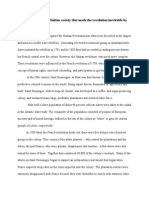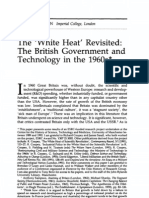Boyle 2008mt Ghxviii The Great Divergence
Boyle 2008mt Ghxviii The Great Divergence
Uploaded by
Michael BoyleCopyright:
Available Formats
Boyle 2008mt Ghxviii The Great Divergence
Boyle 2008mt Ghxviii The Great Divergence
Uploaded by
Michael BoyleOriginal Title
Copyright
Available Formats
Share this document
Did you find this document useful?
Is this content inappropriate?
Copyright:
Available Formats
Boyle 2008mt Ghxviii The Great Divergence
Boyle 2008mt Ghxviii The Great Divergence
Uploaded by
Michael BoyleCopyright:
Available Formats
Michael Boyle
Hertford College
European concentration, conflict and competition in relation to the great divergence In the late 18th and early 19th centuries, the economic and geo-political structure of the globe was dramatically altered, and a new world order was created that would last the best part of two hundred years. More significant than that, however, was a technological revolution, which, despite being initiated in the tiny island of Great Britain, opened up the possibility of modernisation and development to the rest of the world forever. This was the era of the 'great divergence', a term coined by K Pomeranz in reference to the separation of the economic trajectories of Europe and China. Nevertheless, one must not be tempted into thinking that this parting of the ways was the result of some intercontinental slugging match between west and east. Economic development was never geographically uniform across either China or Europe; modernisation was initially a highly localised phenomenon before it was disseminated around a large land area. The key locations for our study are north-west Europe (around Britain and the Low Countries) and, in China, the Kiangan region on the Yangtze delta. This essay will first attempt to establish that there was a divergence in economic fortunes between these two areas (and the wider continents of which they were a part) and that it ultimately resulted not from variances in intellectual, political or even natural environments, but the exceptional technical progress made in Europe. The source of this European inventiveness is in some ways impossible to truly determine, but I argue that the geographical and political closeness of the competing European powers encouraged innovation and the rapid adoption of new technologies. This competition therefore pushed Europe to a higher state of technical development than its eastern counterpart, China. The existence of a 'great divergence' rests upon two assumptions. These are, firstly, that at the start of the period, the economic fortunes of China and Europe were roughly equivalent in the 18th century and, secondly, that, by the end of the 19th, the west had not only overtaken, but developed a significant lead over, the east. The second of these assumptions is indisputable at the start of the twentieth century, European industry was mechanised and highly efficient a machine operator in Lancashire could churn out the finest textiles 400 times faster than a highly skilled traditional Indian artisan;1 westerners (either in Europe or the 'new-Europes' of North America or Australasia) controlled vast global trade networks exchanging unprocessed eastern commodities for value-added processed goods; European institutions from Christianity to the printed newspaper were spread around the world; and British GDP per capita was roughly ten times that of China, a country by the point on the cusp of Malthusian crisis. And from the early 19th Century, the Islamic world had broken several hundred years of haughty intellectual isolation (stemming from its evident cultural, and assumed religious, superiority in the medieval period) to investigate the powerful forces at work in the European economy. European studies of economics were for the first time translated into Arabic, Persian and Turkish, while knowledge of European languages became seen as desirable, and eventually necessary, for the privileged classes. Our first assumption also seems to be confirmed by historical data. While European traders struggled to produce anything other than gold bullion that was valued by their 18th century trading partners, India produced perhaps as much as two thirds of global manufacturing exports, largely due to its highly developed textiles sector. Meanwhile, the figures for life expectancy and income per head in Britain and China were approximately equal in 1800.2 The historical evidence, therefore, appears to correlate with our assertion of a 'great divergence' between east and west. * * *
However, our first assumption (and consequently our temporally specific great divergence thesis) was rejected by EL Jones in his 1981 book entitled 'The European Miracle'. Jones was one
1 J Darwin, After Tamerlane 2 K Pomeranz, The Great Divergence
Michael Boyle
Hertford College
of a number of historians to argue that the dramatic events of the 19th century were in fact merely the culmination of a long term process of gradual economic change that in Europe extended back three hundred years or more. Jones consequently argued that by the 18th century, Europe had laid the foundations for a dynamic market based economy, and was in this respect already more modern than the eastern half of Eurasia. In supporting this argument, Jones pointed to European cultural advantages - the Protestant work ethic first outlined by Weber but dating back to the Lutheran reformation, and the European family structure, which was supposedly a fertility restraint that precluded a subsistence crisis and allowed for greater investment in human capital. Jones also recalled the argument made by D North that the political structures of north-west Europe, born in the fires of constant competition and regular conflict with neighbouring states, limited the absolute authority of national rulers and so ensured greater security of property rights. Property rights are of course an essential prerequisite to economic exchange, and the developments identified by North could be connected to the growth of the European financial sector (as they enshrined the security of credit), and the flourishing of invention in the 19th century (the patent system at least began to guarantee intellectual property over innovations). One could equally include the protoindustrialisation model expounded by F Mendels as providing evidence that the evolution of a modern, industrial economy had already begun in the early 18th century. This theorem extrapolates from the English pattern of development to suggest that the appearance of rural cottage industry is a direct and necessary precursor to urban factory industry, and as such is part of the same process. Yet we must question any suggestion that the economic growth of Europe at this point either was part of a long term path to modernity or was even exceptional for the time. For a start, one must be sceptical of arguments centred around cultural differences; they can only ever have oblique, indirect and therefore ambiguous effects. This is most tellingly demonstrated by debates surrounding the impact of Confucian ideals - a deep respect for authority, the subjugation of the individual to the needs of society - on East Asian economic growth. (Note the implication that Confucianism represents a deviation from the Western norm.) These attitudes have been blamed for Chinese economic stagnation after 1400 despite the fact that they also prevailed during the period of technological vitality that preceded it. And to make matters worse, they have since been identified as a motor for the Japanese economic miracle since the second world war! The potential economic impact of family structures is also uncertain. For example, the tendency for Chinese families to outsize European ones has been criticised for reducing possible investment in human capital. I could be argued, however, that they provided a free and accessible source of child care, and so had the opposite effect. In any case, it is dangerous to generalise that China was closer to a subsistence crisis than Europe as much of the country could accommodate population increases, a fact noticed by the Qing administration itself. The Chinese state positively encouraged internal migration from populous areas to depopulated ones over 10 million people were persuaded to relocate by the payment of travel costs and the offer of start up loans. The institutional argument, particularly with regard to the development of credit markets may seem convincing to a western reader, but the idea that liberalism and economic development go hand in hand reflects a narrow minded, teleological attitude. True, restraints on governmental authority are one way to secure property rights and develop financial institutions, but they are certainly not the only way. As long as the interests of ruler and ruled are aligned in support of a stable and secure economic system, the relative power of either party becomes insignificant. This was visibly demonstrated by late 19th century Europe's most successful economy, Germany, and is again evident in modern day China. And we should not forget that Britain, that great bastion of parliamentary democracy, did not acquire universal suffrage until 1918. Finally, the assertion that proto-industrialisation inevitably leads to modernity has been disproven by the fact that China had in fact a more complex rural industrial base than Britain in the 18th century but failed to experience a resultant development in urban manufacturing (the very essence of the great divergence). In fact, it has been argued that China reached a 'high level
Michael Boyle
Hertford College
equilibrium trap' in which the traditional economy of the late 18th and early 19th century, with its integrated national markets and efficient uses of organic energy, was productive enough to sustain population increase and so provided little incentive for technological improvements. When one considers the fact that proto-industrialisation implies rural development when industrialisation implies urban development, it becomes clear that, far from engendering western style industrial growth, proto-industrialisation necessitates a dramatic structural transformation in the economy. This did occur in Britain, but only due to exceptional circumstances, to which I shall now turn. The one area in which a case could be made in support of the very long run industrialisation thesis is that of the British agricultural revolution. The British agrarian economy was able to escalate its productive capacity by 250% in the years 1500-1750 while the fraction of the population working on the land declined from 74% to a mere 45%.3 This, it is true, could be attributed to the enclosures of vast swathes of the country and the resulting application of animal capital to it, but debate remains concerning the true impact of the privatisation of the country's land markets. In any case, this modern agricultural sector was not visible in the majority of Europe and so cannot be applied to the great divergence debate in general. In France, one of the more developed countries in the continent, agricultural productivity, rural to urban migration and the liberalisation of land markets all stagnated in the period, while in Spain, hereditary inheritance continued to dominate and so prevent the efficient allocation of resources. Upon close inspection, Chinese agriculture appears rather similar to that of Europe in the period. Productivity, buoyed by the application of fertilisers and an efficient system of irrigation waterways the latter of which feudal relationships in France inhibited - tended to match or even better European levels. In the Yangtze basin farmers were able to specialise in cash crops and draw in food and supplies from other regions, demonstrating market integration and the prospect of Smithian growth.4 At the same time, the system was not free from imperfections, as can be seen in the theoretical first refusal held by locals on property put up for sale, which, like hereditary inheritance in Spain, reduced efficiency.5 (Alternatively, it could be argued that such a system reduced the transaction costs of land exchange, thereby encouraging mutually beneficial trade.) To conclude, differences in the pre-industrial Chinese and European economies were, with the possible exception of Britain, not sufficient to suggest that they had reached differing stages of development. * * *
It now therefore seems safe to say that there was indeed a great divergence in Chinese and European economic trajectories in our period, although we may feel a little uncomfortable with making generalisations about such large and diverse geographical areas. We must now seek an explanation for this phenomenon. By far the most significant aspect of European modernisation was the shift from a reliance on organic energy (particularly man or animal power and wood) to one of mineral energy, specifically coal. The use of coal and steam power, by vastly increasing the economy's energy capabilities, offered Europe a long term (though perhaps not permanent) escape from the Malthusian subsistence trap. It facilitated the exponential expansion of the workforce, the development of myriad new technological innovations and the growth of pan-continental lines of communication and transport. In doing so, it vastly reduced the costs of international trade, which brought further stimuli to the European economy by opening up ever cheaper sources of raw material inputs for industry, and creating ever increasing demand for industrial exports. The new technologies allowed small numbers of Europeans to exert imperial control over much of Asia and (admittedly with the significant support of several million enslaved African workers) to make
3 R Allen, 'Economic structure and agricultural productivity in Europe, 1300-1800', European Review of Economic History 4 R Bin Wong, China Transformed 5 K Pomeranz, The Great Divergence
Michael Boyle
Hertford College
maximal use of the new world to the west of Europe. It was technology, and not either Empire or geographical discovery that modernised Europe. The latter two phenomena certainly offered significant economic benefits to Europe - either by providing raw materials, land for colonisation or coerced and beneficial trade - but without technological improvements, Europe would have remained a traditional, Malthusian economy, albeit with much greater breathing space. But the sudden increase in European inventiveness from the 18th century is difficult to explain, as the concept of invention is so abstract and without obvious, direct causes. What must initially be established is that, before the days of national research and development funding, technological spurts were peculiarly rare occurrences in history, so it is not helpful to seek inadequacies in the Chinese situation that precluded a period of high inventiveness. Instead, we must look to Europe for answers. It has been suggested that supply side shortages or bottlenecks may have promoted innovation, but this seems to apply more to the adoption of new technologies than to the process of invention itself. In 18th century England, the use of coal for smelting was first developed during a time of surplus charcoal, but its only proliferated decades later as the price of charcoal escalated.6 Equally, the Chinese province of Kiangan faced serious resource stresses, yet did not develop inventive solutions to them. It is too easy to assume that Britain was blessed with just the right combination of resource endowments and shortages to promote industrialisation: surely the actual path of industrialisation was influenced by the natural endowments available to the economy. Alternatively, J Mokyr has posited that the rational, scientific spirit of the enlightenment promoted spirit of invention which bore fruit over the following century. Certainly an increased interest in, and understanding of, the sciences among the wider population may have had a positive impact on the level of invention, but Mokyr's line suffers from the familiar problems associated with all cultural arguments, and is consequently difficult to substantiate. Our fundamental problem is that we are unable to truly explain the precise mental processes that prompt human invention, and so cannot attribute causes to specific cases of technical innovation in the period. Nevertheless, there is an explanation for European success in this field in general, and it springs from the dense concentration of rival states within a relatively small geographical area. The 18th and 19th centuries were a period of constant competition and near constant conflict between the rival powers of Britain, France, Spain, Holland and later Germany. No country could afford to embrace antiquated technologies and each was desperate to gain an edge over the others. In the same way that the situation of competition may have aided the establishment of liberal government (as D North argued), it provided a fertile breeding ground for innovations. Ideas leaked across porous national borders as states promoted 'industrial espionage' and new micro-inventions were constantly being developed. The result of this was that, although Britain was the first to key technologies such as the steam engine or the railway, its European rivals were quick to catch up, and from 1850, Britain began to lose ground. Europe saw a combination of both political and economic competition in the period: just as nations attempted to dominate each other, firms involved in the production of goods and services battle with each other within an increasingly competitive continental market. The modernisation of the continent as a whole was therefore quicker than that of China, which was politically, economically and geographically isolated from the world's competitive hub. Although we still cannot explain the increase in macro-inventiveness, we can put the number of micro-inventions and their speedy dissemination throughout the whole of Europe down to the sheer concentration of rival states in a modest geographical area. Of course, with such a complex and wide ranging problem as the industrialisation of Europe and its economic divergence from China, we must accept that our solutions will not be as simple or one dimensional as I have suggested. For example, my thesis does not explain why Europe became so inventive at the specific point in time that it did; after all, European states had been in conflict for all time. To answer this, we must look further into the environment of the 19th century, the capitalist institutions that fostered technological innovation in Europe and also contiguous global geopolitical 6 Hyde C, 'The Adoption of Coke-Smelting by the British Iron Industry 1709-1790', Exploration in Economic History
Michael Boyle
Hertford College
developments. But we still may conclude that European and Chinese economic fortunes separated in the 18th and 19th centuries not because of any specific inadequacies within the Chinese system but simply because it did not experience the historically unusual event of a sudden and general leap forward in technological progress. And although the precise cause of this occurrence in 19th century Europe (just as in the case of the Chinese spurt in invention up until 1400) remains an enigma, it was certainly encouraged by the geographical closeness of the several European powers, and the intense economic and political rivalry between them. 2755 words Bibliography K Pomeranz, The Great Divergence J Darwin, After Tamerlane R. Bin Wong, China Transformed: Historical Change and the Limits of European Experience. M.Elvin, The Pattern of the Chinese Past E.L.Jones, The European Miracle B.Lewis, The Muslim Discovery of Europe J Mokyr The Great Synergy: The European Enlightenment as a Factor in Modern Economic Growth R Brenner, England's Divergence from China's Yangzi Delta: Property Relations, Microeconomics, and Patterns of Development Alternative Questions How comfortable should we be with making continental generalisations? Account for the rise in European inventiveness in the 18th and 19th centuries. How modern was early 18th century Europe compared to a) the rest of the world at the time and b) Europe in previous centuries? How similar was the Islamic world to China before, during and after the 'great divergence'?
You might also like
- Karen Brodkin - How Jews Became White Folks and What That Says About Race in America-Rutgers University Press (1998) PDFDocument268 pagesKaren Brodkin - How Jews Became White Folks and What That Says About Race in America-Rutgers University Press (1998) PDFSarper Erinc Akturk100% (8)
- Clinical Manual of Cultural PsychiatryDocument631 pagesClinical Manual of Cultural PsychiatryGökhan Deniz100% (2)
- New Deal Civics EssayDocument4 pagesNew Deal Civics EssayAlex Burke100% (1)
- Meiji Restoration Bibliography Primary SourcesDocument4 pagesMeiji Restoration Bibliography Primary Sourcesapi-2725826490% (1)
- The British Library's Strategy 2008 - 2011: Our PurposeDocument2 pagesThe British Library's Strategy 2008 - 2011: Our PurposeAfrim TonuziNo ratings yet
- Santa Barbara Village Business PlanDocument45 pagesSanta Barbara Village Business PlanWilliam MacfadyenNo ratings yet
- WITS Info Sheet 2013 FEMDocument3 pagesWITS Info Sheet 2013 FEMRodrigo Bravo da RosaNo ratings yet
- Essay On The Timing and Cause of Great DivergenceDocument4 pagesEssay On The Timing and Cause of Great DivergenceAshwin Senthil KumarNo ratings yet
- 03 - The Great DivergenceeDocument4 pages03 - The Great DivergenceeEmanuele Giuseppe ScichiloneNo ratings yet
- STUDER, Roman (2015) The Great Divergence Reconsidered Europe, India, and The Rise To Global Economic Power (Cambridge University Press)Document246 pagesSTUDER, Roman (2015) The Great Divergence Reconsidered Europe, India, and The Rise To Global Economic Power (Cambridge University Press)SpamparatiNo ratings yet
- MeisenzahlDocument3 pagesMeisenzahlhugoperaltaNo ratings yet
- (M. Havinden) Colonialism and Development BritainDocument36 pages(M. Havinden) Colonialism and Development BritainMihaela VerdesNo ratings yet
- How Did The Spice Trade Influence Different CulturesDocument8 pagesHow Did The Spice Trade Influence Different Culturesapi-456261564100% (2)
- PDFDocument285 pagesPDFJase Harrison100% (1)
- Living Knowledge The British Library 2015-2023Document20 pagesLiving Knowledge The British Library 2015-2023LJ's infoDOCKETNo ratings yet
- Eric Williams Capitalism and Slavery DocumentDocument6 pagesEric Williams Capitalism and Slavery DocumentLene Angel MarshallNo ratings yet
- Trade During The Industrial Revolution - EditedDocument3 pagesTrade During The Industrial Revolution - EditedJames YangNo ratings yet
- Italian RenaissanceDocument7 pagesItalian RenaissanceMareina HarrisNo ratings yet
- CivilizationDocument19 pagesCivilizationAung Htun LinnNo ratings yet
- Final History Research PaperDocument7 pagesFinal History Research PaperOnika BlandinNo ratings yet
- The Agrarian Revolution in BritainDocument4 pagesThe Agrarian Revolution in BritainTaaboNo ratings yet
- Why Did The Industrial Revolution Start in BritainDocument95 pagesWhy Did The Industrial Revolution Start in BritainJorge Antonio Amnav100% (1)
- The European Enlightenment The Industrial Revolution and Modern Economic Growth 2007 2j6gh1e PDFDocument27 pagesThe European Enlightenment The Industrial Revolution and Modern Economic Growth 2007 2j6gh1e PDFMichelle InfanzonNo ratings yet
- Archaeology, or Archeology, Is The Study Of: AntiquariansDocument19 pagesArchaeology, or Archeology, Is The Study Of: AntiquariansAmit TiwariNo ratings yet
- What Do You Understand by Doing 'Connected Histories'Document10 pagesWhat Do You Understand by Doing 'Connected Histories'Sayan LodhNo ratings yet
- Democracy and The Middle AgesDocument54 pagesDemocracy and The Middle AgesNelson PerezNo ratings yet
- A Feasibility Study On The Implementation of A Micro-Hydro Scheme in Sioma, ZambiaDocument17 pagesA Feasibility Study On The Implementation of A Micro-Hydro Scheme in Sioma, ZambiaEngineers Without Borders UKNo ratings yet
- A Comparison Between The Eric Williams DDocument16 pagesA Comparison Between The Eric Williams DRichard BhainieNo ratings yet
- The Social Impact of The Industrial RevolutionDocument10 pagesThe Social Impact of The Industrial Revolutionelsayedola13No ratings yet
- Shashi Tharoor Speech at OxfordDocument10 pagesShashi Tharoor Speech at OxfordAnonymous RhV17fUtpNo ratings yet
- Why Are Some People Better Off Than Others?Document21 pagesWhy Are Some People Better Off Than Others?Paul CammackNo ratings yet
- The Problem ofDocument24 pagesThe Problem ofGeraldo CoutoNo ratings yet
- Tunisian RevolutionsDocument76 pagesTunisian RevolutionsAlberto Valz GrisNo ratings yet
- Shitang Village Internet Conference CenterDocument13 pagesShitang Village Internet Conference CenterFarahNo ratings yet
- Lesson 21 Slavery in America, The "Peculiar Institution" StudentDocument25 pagesLesson 21 Slavery in America, The "Peculiar Institution" StudentGabriel Balderrama100% (1)
- Relationship Between Capitalism and Slavery in EuropeDocument9 pagesRelationship Between Capitalism and Slavery in EuropePreeti KumariNo ratings yet
- The Culture of CapitalismDocument7 pagesThe Culture of Capitalismdazzling88No ratings yet
- The Making of A Global WorldDocument14 pagesThe Making of A Global WorldAjay AnandNo ratings yet
- Imperialism PDFDocument52 pagesImperialism PDFHeidi HarrisNo ratings yet
- BMamigonian-PhD2002 TESE LIBERDADE NO ATLANTICODocument346 pagesBMamigonian-PhD2002 TESE LIBERDADE NO ATLANTICOMary Souza SantosNo ratings yet
- From Burke To Schama - Historiography French RevolutionDocument5 pagesFrom Burke To Schama - Historiography French RevolutionSabrina Alencastro100% (1)
- Agrarian Class Structure and Economic Development in Pre-Industrial EuropeDocument99 pagesAgrarian Class Structure and Economic Development in Pre-Industrial Europekritisk kulturNo ratings yet
- Labour in Medieval IslamDocument27 pagesLabour in Medieval Islamshrutigarodia0% (1)
- Ancient Greece PowerpointDocument32 pagesAncient Greece Powerpointapi-292473896No ratings yet
- The Industrial Rev NotesDocument4 pagesThe Industrial Rev Notesʚĩ FàDìâ Ĩɞ100% (1)
- Agricultural Revolution Notes and DrillsDocument6 pagesAgricultural Revolution Notes and Drillsapi-245769776No ratings yet
- World History Semester 1 Exam ReviewDocument2 pagesWorld History Semester 1 Exam Reviewipar16No ratings yet
- Economic and Political Motives: Factors That Motivated European Kingdoms To Explore The WorldDocument7 pagesEconomic and Political Motives: Factors That Motivated European Kingdoms To Explore The WorldHaru HaruNo ratings yet
- The Nordic Countries and Africa - Old and New RelationsDocument54 pagesThe Nordic Countries and Africa - Old and New RelationswhitemaleandproudNo ratings yet
- Causes of Haitian RevolutionDocument2 pagesCauses of Haitian Revolutionapi-339252193No ratings yet
- AP European History Chapter 18 NotesDocument12 pagesAP European History Chapter 18 NoteslevisaadaNo ratings yet
- Renaissance PowerpointDocument34 pagesRenaissance Powerpointapi-248620271No ratings yet
- Confucian Values and Their ImplicationsDocument18 pagesConfucian Values and Their ImplicationsJohn Kenneth NatoNo ratings yet
- C. P. Snow As Anti-Historian of British Science: Revisiting The Technocratic MomentDocument22 pagesC. P. Snow As Anti-Historian of British Science: Revisiting The Technocratic MomentUrko Gorriñobeaskoa ArtolozagaNo ratings yet
- The French Revolution UnfoldsDocument32 pagesThe French Revolution UnfoldsMisha MunickNo ratings yet
- High Middle Ages EssayDocument2 pagesHigh Middle Ages EssayMaureen WoodNo ratings yet
- 1831 RevoltDocument11 pages1831 RevoltFàriýah MohamedNo ratings yet
- Language Culture and EducationDocument261 pagesLanguage Culture and EducationMilton GeorgeNo ratings yet
- Edgerton White Heat (Uk, 1996)Document30 pagesEdgerton White Heat (Uk, 1996)IdeaTrackNo ratings yet
- The Glorious RevolutionDocument18 pagesThe Glorious RevolutionjericolismNo ratings yet
- Towards A History of ProductionDocument6 pagesTowards A History of ProductionDavid EdgertonNo ratings yet
- The Great Events by Famous Historians, Volume 08 The Later Renaissance: from Gutenberg to the ReformationFrom EverandThe Great Events by Famous Historians, Volume 08 The Later Renaissance: from Gutenberg to the ReformationNo ratings yet
- 2nd Topic in Understanding CultureDocument4 pages2nd Topic in Understanding CultureMhay Anne PerezNo ratings yet
- GAZZATE of ADE FAll 2019-2021 & One College of 2020-2022Document27 pagesGAZZATE of ADE FAll 2019-2021 & One College of 2020-2022Tageen ShahNo ratings yet
- Unit 4 ProjectDocument11 pagesUnit 4 Projectapi-266092088No ratings yet
- The First China-Japanese WarDocument6 pagesThe First China-Japanese WarFatinSyafirahJamilNo ratings yet
- English10 As4 Critiquingatext Final AdvinculaDocument8 pagesEnglish10 As4 Critiquingatext Final AdvinculaMoira Ellize AdvinculaNo ratings yet
- Cambridge International General Certificate of Secondary EducationDocument24 pagesCambridge International General Certificate of Secondary Educationwalaa ahmadNo ratings yet
- Elections 2004 Statistical DataDocument303 pagesElections 2004 Statistical Datanavn76No ratings yet
- Resolution IicDocument2 pagesResolution IicSantosh PatilNo ratings yet
- Urban Identity and Iconic BuildingsDocument169 pagesUrban Identity and Iconic Buildingsimhotabdoo100% (3)
- Consti1 Digests 1AA JJ Digest Team PDFDocument299 pagesConsti1 Digests 1AA JJ Digest Team PDFGraziella Andaya100% (2)
- DIVISI (恢复的)Document34 pagesDIVISI (恢复的)Asta PratamaNo ratings yet
- Legal Consequences of The Construction of A Wall IDocument4 pagesLegal Consequences of The Construction of A Wall IChristian AbenirNo ratings yet
- Napoleon Revision NotesDocument11 pagesNapoleon Revision Noteswebby88100% (6)
- POL109 PaperDocument8 pagesPOL109 Paperjustin.ha2004No ratings yet
- PlacesDocument4 pagesPlaceswuubbbyyyyNo ratings yet
- Cbse Human Rights and Gender StudiesDocument7 pagesCbse Human Rights and Gender StudiescommunistpapiNo ratings yet
- John Stein Beck, The Grapes of Wrath in The Context of California HistoryDocument7 pagesJohn Stein Beck, The Grapes of Wrath in The Context of California HistoryJohn UmNo ratings yet
- Public Opinion and Survey Research - 62323412 - Revision - 4 To 8th MayDocument13 pagesPublic Opinion and Survey Research - 62323412 - Revision - 4 To 8th MaymanjulgtmNo ratings yet
- The Jamaican ConstitutionDocument164 pagesThe Jamaican ConstitutionBee CocoNo ratings yet
- Kanishka Goonewardena - Space-Time-Revolution - Spring 2012 JPG1503 SyllabusDocument3 pagesKanishka Goonewardena - Space-Time-Revolution - Spring 2012 JPG1503 Syllabusstevekay_pdxNo ratings yet
- Island of Palmas CaseDocument1 pageIsland of Palmas CaseJerommel GabrielNo ratings yet
- Business Ethics - Four Spheres of Executive Responsibility - BadaraccoDocument17 pagesBusiness Ethics - Four Spheres of Executive Responsibility - BadaraccoEduardo Ariel Fernández Soto.No ratings yet
- CBYDP ABYIP LinkageDocument32 pagesCBYDP ABYIP LinkageBatralo P OrganicsNo ratings yet
- A PYQ Workbook of Indian Polity and GovernanceDocument329 pagesA PYQ Workbook of Indian Polity and GovernanceKomma ThirupathiNo ratings yet
- Clash of CivilizationsDocument18 pagesClash of CivilizationsCuma Kaya100% (3)
- NOORANI, Counter Hegemony in The Colony and PostcolonyDocument303 pagesNOORANI, Counter Hegemony in The Colony and PostcolonyMaria TNo ratings yet
- Yugoslavia - Ivo Banac, 1992Document22 pagesYugoslavia - Ivo Banac, 1992Alexandar KonkolNo ratings yet

























































































